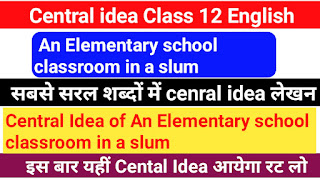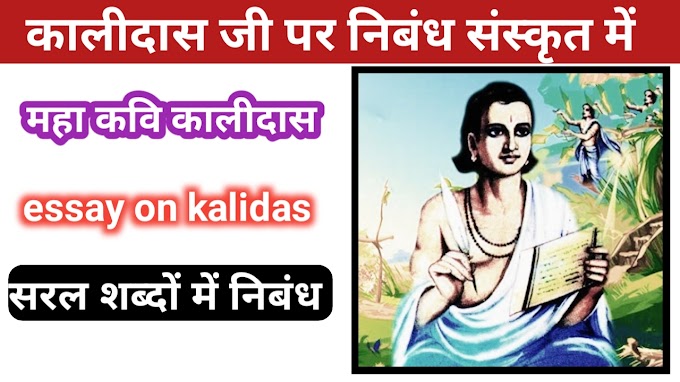Central Idea of An Elementary school classroom in a slum
02 An Elementary School Classroom in a Slum
नमस्कार मित्रों स्वागत है आपका हमारी वेबसाइटwww.Subhanshclasses.com में यदि आप गूगल पर सर्च कर रहे हैं Central Idea of An Elementary school classroom in a slum
तो आप बिल्कुल सही जगह पर आ गए हैं हम आपको आपके english पेपर में आने वाले cental idea ko बताने वाले हैं यदि आप YouTube पर देखना चाहते हैं तो आप अपने यूट्यूब पर सर्च करे Subhansh classes वहा पर आपको हमारा चैनल मिल जायेगा, आप उसे जल्दी से subscribe कर लीजिए। हमारे यूट्यूब चैनल पर आपको पढाई से सम्बंधित सभी जानकारी दी जायेगी
Central Idea of An Elementary school classroom in a slum
Central Idea of the Poem
Stephen Spender has presented a true picture of the life of the school children living in the slum. The children are in a very miserable condition due to their poverty and illiteracy. They are depressed and their pale faces express sadness. They are physically very weak and undernourished. Spender voices his concern for these children who live all their life in slums and have no opportunity to enjoy the real blessings of life. He makes a appeal to the educated and affluent sections of the society to help them to improve the education facilities and living conditions of these childrens.
स्टीफन स्पेण्डर ने झुग्गी/बस्ती में रहने वाले स्कूली बच्चों के जीवन का वास्तविक चित्रण प्रस्तुत किया है। यहाँ बच्चे गरीबी और निरक्षरता के कारण बहुत ही दयनीय स्थिति में हैं। वे उदास हैं और उनके पीले चेहरे दुःख व्यक्त कर रहे थे। वे शारीरिक रूप से बहुत दुर्बल हैं और कुपोषित हैं। स्पेण्डर इन बच्चों के प्रति अपनी चिन्ता व्यक्त करते हैं, जो अपना पूरा जीवन मलिन बस्तियों में व्यतीत करते हैं और उनके पास जीवन की सुखदायक वस्तुओं का आनन्द लेने का कोई अवसर नहीं है। वे समाज के शिक्षित और समृद्ध वर्गों से विनती करते हैं कि वे इन बच्चों की शिक्षण सुविधा और रहन-सहन की स्थितियों में सुधार करने में इनकी सहायता करें।
EXTRACT BASED QUESTIONS
Read the extract given below and answer the questions that follow.
Far far from gusty waves these children's faces. Like rootless weeds, the hair torn round their pallor: The tall girl with her weighed-down head.
1. Who are these children?
ये बच्चे कौन है?
Ans. These children are the poor children who live in the slum.
2. What does the poet mean by 'gusty waves'?
‘Gusty waves' से कवि का क्या तात्पर्य है?
Ans. By 'Gusty waves' the poet means the beautiful sights of nature which are not visible in the slum.
3. What has possibly weighed down the tall girl's head?
लम्बी लड़की के सिर को सम्भवतः किसने बोझिल किया हुआ है?
Ans. The tall girl's head has possibly been weighed down by being burdened with sad thoughts about her misfortune, which is making her feel depressed.
4. Identify the figure of speech used in these lines.
इन पंक्तियों में प्रयुक्त अलंकार को पहचानें?
Ans. Simile is used in these lines when the unkempt hair is compared to rootless weeds.
"The stunted unlucky heir Of twisted bones, reciting a father's gnarled disease, His lesson, from his desk. At back of the dim class One unnoted, sweet and young. His eyes live in a dream,Of squirrel's game, in tree room, other than this."
1. Who is the 'unlucky heir"?
'दुर्भाग्यशाली उत्तराधिकारी' कौन है?
Ans. The boy who has a stunted growth with twisted bones, sitting in the slum school classroom, is the 'unlucky heir'.
2. What has he inherited?
उसे विरासत में क्या मिला है?
Ans. He has inherited the arthritis of his father; as result his growth remains stunted.
3. Who is sitting at the back of the dim class?
मन्द कक्षा में पीछे कौन बैठा है?
Ans. A sweet young boy is sitting at the back of the dim class. He is daydreaming of squirrels playing in a tree.
4. What quality of the unlucky heir is depicted in the stanza?
दुर्भाग्यशाली उत्तराधिकारी का क्या गुण छन्द में दर्शाया गया है?
Ans. The unlucky heir is depicted with twisted bones which he has inherited from his father, who suffers from arthritis.
5. What does the child want to enjoy?
बच्चा किसका आनन्द लेना चाहता है?
Ans. The child wants to enjoy seeing squirrels playing in the tree outside the classroom.
"On sour cream walls, donations. Shakespeare's head. Cloudless at dawn, civilised dome riding all cities.Belled, flowery, Tyrolese valley. Open-handed map Awarding the world its world."
1. How were the walls built?
दीवारे कैसे बनाई गई थी?
Ans. The walls were built with donations from various sources.
2. What do you find in the classroom?
आप कक्षा में क्या पाते हैं?
Ans. In the classroom we find malnourished children, one innocent sweet child, a picture of Shakespeare, a world map, a picture of a modern city and of the Tyrolese valley.
3. What is the significance of Tyrolese valley?
टाइरॉलीज घाटी का महत्त्व क्या है?
Ans. The significance of Tyrolese valley is a contrast to the condition of the classroom, as it is a place of beauty they have never seen or which is unknown to them. It can arouse in them a desire to be part of it.
4. What does the word 'belled' mean?
'Belled' शब्द का क्या अर्थ है?
Ans. The word 'belled' means either that the Tyrolese valley is in the shape of a bell or that there are bells around the grazing cows in the valley.
"And yet, for these Children, these windows, not this map, their world,Where all their future is painted with fog,A narrow street sealed in with a lead sky Far far from rivers, capes and stars of words."
1. Who are the 'children' referred to here?
यहाँ पर सन्दर्भित 'बच्चे' कौन हैं?
Ans. The children' referred to here are the poor children living in the slum.
2. Which is their world?
उनकी दुनिया कौन-सी है?
Ans. Their world is the dull and unpleasant classroom and its windows amongst the dirty surroundings of the slum.
3. How is their life different from that of other children?
उनका जीवन अन्य बच्चों से किस प्रकार भिन्न है?
Ans. The children of the slum are emaciated and poverty-stricken, as against the other children who are healthy and have all the comforts and luxuries of life. The life of the slum children is filled with darkness and hopelessness.
4. Why is the future of these children 'painted with a fog?
इन बच्चों के भविष्य को कोहरे से क्यों चित्रित किया गया है?
Ans. The future of these children is dark and uncertain, meaning that it cannot be seen. So, the poet says that it is 'painted with a fog."
5. Which map is the poet talking about in the above lines?
कवि उपरोक्त पंक्तियों में किस मानचित्र के बारे में बात कर रहा है?
Ans. The poet is talking about the map of the world hung in the classroom.
6. What sort of future do the slum children
have?
मलिन बस्तियों के बच्चों का भविष्य कैसा है?
Ans. The slum children have a dark and uncertain future.
"With ships and sun and love tempting them to steal For lives that slyly turn in their cramped holes From fog to endless night?"
1. Who are them' referred to in the first line?
पहली पंक्ति में उन्हें कहकर किसे सम्बोधित किया गया है?
Ans. "Them' here refers to the poor, emaciated children of the slum.
2. What tempts them?
उन्हें क्या लुभाता है?
Ans. They are tempted by all the beautiful things of the world, the luxuries and the lifestyle that the rich enjoy. They are tempted to steal them, as they cannot possess these otherwise.
3. What does the poet say about their lives?
कवि 'उनके' जीवन के बारे में क्या कहता है?
Ans. The children of the slum live amidst dirty surroundings in cramped houses which are dark and unpleasant. The poet is not happy with the way these children are compelled to live.
4. What do you understand by 'From fog to endless night'?
From fog to endless night' से आप क्या समझते है?
Ans. From fog to endless night' means from morning till night. The poor children of the slum have a miserable existence; they suffer from morning to night everyday.
On their slag heap, these childrenWear skins peeped through by bones and spectacles of steel With mended glass, like bottle bits on stones.
1. Name the poem and the poet.
कविता और कवि का नाम बताइए।
Ans. The poem is 'An Elementary School Classroom in a Slum' and the poet is Stephen Spender.
2. Which image is used to describe the poverty of these children?
इन बच्चों की गरीबी का वर्णन करने के लिए किस प्रतीक का उपयोग किया गया है?
Ans. The images used to describe the poverty of these children are 'skins peeped through by bones' and 'spectacles of steel with mended glass'.
3. What sort of life do these children lead? ये बच्चे किस तरह का जीवन जीते हैं?
Ans. The children of the slum lead a life with dirty surroundings in cramped houses which are dark, unpleasant and foggy, meaning that they have 'dim' future.
4. Identify and name the figure of speech used in line 3.
पंक्ति 3 में प्रयुक्त अलंकार को पहचानें और उसका नाम बताएँ।
Ans. The figure of speech used in line 3 is a simile, as the mended glass is compared with bits of bottles.
"Break 0 break open till they break the town And show the children to green fields, and make their world Run azure on gold sands, and let their tongues Run naked into books the white and green leaves open History theirs whose language is the sun."
1. What is meant by 'Break O break"?
'ब्रेक ओ ब्रेक' से क्या अभिप्राय है?
Ans. The poet wants to bring these children out of their filthy surroundings. He wants them to break the shackles that this slum has put on them, so that they can see the outside world.
2. Who are 'they'?
“They' कहकर किसे सम्बोधित किया गया है?
Ans. They' refers to the poor, emaciated children of the slum.
3. What does the poet want for them?
कवि उनके लिए क्या चाहता है?
Ans. The poet wants that these children should be properly educated, because, according to him, history is written by those whose language has the energy and warmth of the sun.
4. Explain "Till they break the town'.
“Till they break the town' की व्याख्या करें।
Ans. The poet wishes the children to break the shackles of the slum so that they can come out of their dirty surroundings into an open area of freedom.
देखे👉👉👉👉
👉👉निबन्ध बोर्ड परीक्षा में यही आयेगा
ये भी देखें 👉👉भी👉👉
ये भी देखे 👉👉👉👉
ये भी देखे 👉👉👉👉
👉👉👉
👉essay on lockdown samasya aur samadhan
👉👉👉
👉एकल खाते को ज्वाइंट खाते में बलवाने हेतू
👉👉👉
👉application for issuing new bank passbook
ये भी देखे👉👉👉👉
ये भी देखें 👉👉👉👉
ये भी देखे 👉👉👉👉
ये भी देखे 👉👉👉👉
👉👉👉
👉essay on lockdown samasya aur samadhan
👉👉👉
👉एकल खाते को ज्वाइंट खाते में बलवाने हेतू
👉👉👉
👉application for issuing new bank passbook
यदि आपको हमारी पोस्ट पसन्द आई हो तो अपने दोस्तो को भी शेयर करें यदि आपको कुछ पूछना है तो कॉमेंट करके जरुर बताएं यदि आपने अभी तक हमारे यूट्यूब चैनल Subhansh classes को subscribe नही किया हो तो अभी जल्दी से subscribe krliajia







